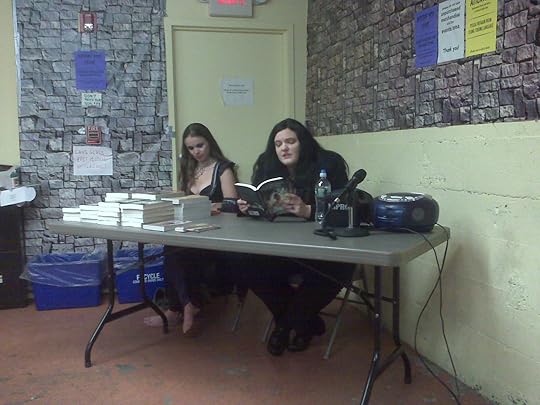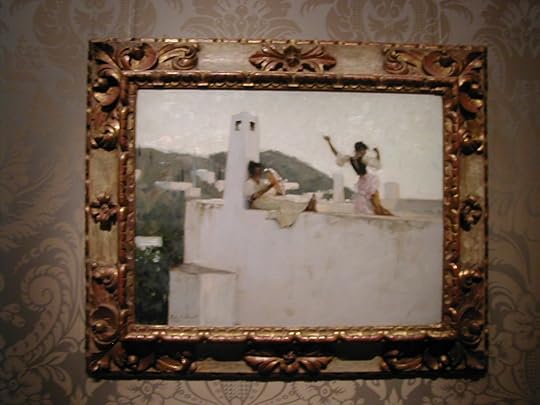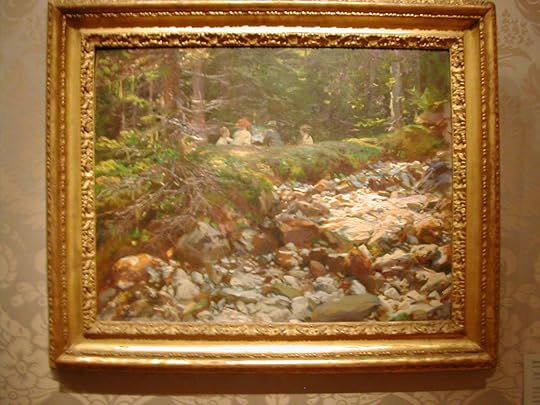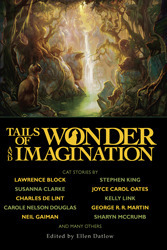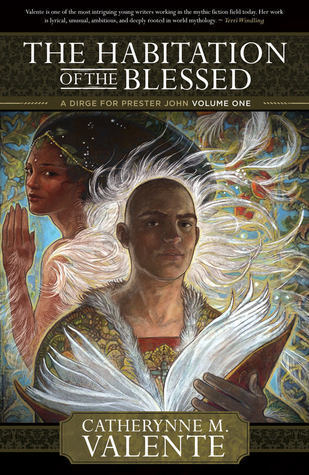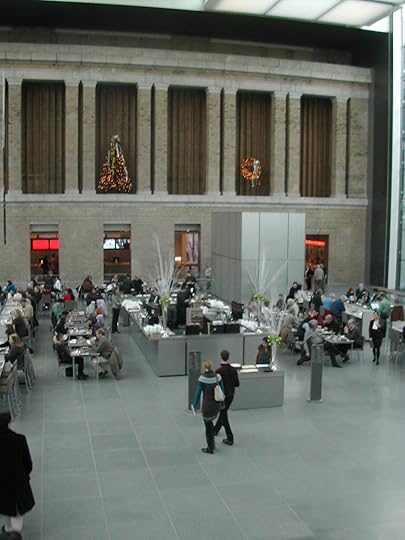Theodora Goss's Blog, page 75
December 11, 2010
Cat's Reading
This afternoon, I went to a reading by Catherynne M. Valente at Pandemonium, the Boston science fiction and fantasy bookstore. I don't usually go to readings, I suppose because what I enjoy is the reading experience itself and what I want are the writer's words inside my head, not echoing in a room at a convention somewhere. But Cat is one of my favorite readers. And she does something that I have always admired, which is incorporate other forms of performance into her readings. The last time I saw her, she was touring with S.J. Tucker. This time, between two of her readings, there was dancing by Katie Lennon. Cat doesn't just read: she puts on a show. I think more writers should do that.
Here are two photographs, one of Cat reading and one of her signing books:
Cat read two sections from The Habitation of the Blessed, which were both gorgeous, as her prose always is. I'm reading the book now, and so far I think it's my favorite of her books.
Afterward, a group of us went out for ice cream, to one of those independent ice cream parlors that have unusual flavors. I ended up with spiced chestnut, which was quite good. And for a couple of hours, we talked shop. Writer's shop is like any other shop. We talk about what we're working on, what we're going to be working on. We talk about publishers, editors, agents. Sales and marketing. What we thought about the carnivorous giraffes in Un Lun Dun. Why no one deals with the fact that Ozma of Oz is transgender, and what we would do with it.
I think it's important to have conversations like these. They give me a sense that I belong to a community, but perhaps more importantly, they give me different ways of thinking about the industry I'm in, which is the writing and publishing industry. There are writers in my field who have done truly innovative things, both in terms of their writing and in the marketing of their work. Cat is one of those, and I've learned so much not only from reading her work but also from watching her approach to her career over the years. She reminds me to be courageous in writing the stories I want to write, and creative in how I get them to my readers. Not a bad lesson to remember, I think, on a Saturday night over ice cream.








The Serial
If you're an observant sort of person, you may have noticed that I have a new button on this website. It's labeled "Serial," and if you click on it, you will see the first thirteen of my posts about the Shadowlands and the Other Country. Enough of you said you were interested in those posts and wanted to hear more of the story that I thought I would put it all together for you. That way, if you just came in, you can go all the way back to the beginning. And you won't miss anything, because after posting on my blog, I'll repost under the Serial button. (It may take a while, but it will eventually appear under Serial.)
Original posts will still appear on my blog, because this is a story I'm telling in real time, as I think and feel it. Or it's a story that Thea is telling, and perhaps all of my posts are really her posts, and Dora is just a character she's creating. I'm not sure which would be the best option, really.
The first part of the serial, made up of those thirteen posts, is called "Into the Other Country," and it's about how Thea traveled to Mrs. Moth's house, and then told the story of the last time she had been there, when she accidentally found herself in the Other Country. She visited Mother Night's house, had several conversations, including with Cordelia the cat (who is as obnoxious in real life as she is in the story), danced with Merlin for the first time, and then returned to the Shadowlands having learned something about herself and her purpose in life. I wasn't thinking about these posts as part of a story when I wrote them. I just wrote them when I was in a particularly dark place and needed somewhere else to go, and the Other Country looked so enticing, with its house of stones and dragon bones, and its trees with leaves and flowers that never fall, and Mother Night herself, who knows the pattern we are all part of, even if we don't know it ourselves.
But I think the next part of the story will have to do with Thea's adventures in the Shadowlands, because as I think I've mentioned, she and her friends, Matilda, Emma, and Mouse, have saved the world several times. And I still need to figure out how.
It's been a new and interesting experience for me, committing to writing on this blog every day. It means that I have to write, no matter how I feel that day. And how I feel seems to find its way into these posts, whether through a story or simply an account of me looking at myself in the mirror and thinking about the future I want to create. Being a writer, or at least the kind of writer I am, anyway means living with one fewer layer of skin than other people seem to have, experiencing the world more directly – sometimes more joyfully, sometimes more painfully. And it means writing out of that, transforming personal experience into stories. So I don't know where these posts about the Shadowlands and the Other Country will go. There is no larger plan, just what I think about on any particular day. I hope you enjoy the journey.








December 10, 2010
The Horrible Year
Today, at the university, I looked at myself in the bathroom mirror. There was Anxiety at my left shoulder, and Depression at my right. Insomnia was at home, taking a nap so she could keep me up later.
And a thought came to me. It was, "You will never do anything harder than this."
I've done some difficult things in my life. I've gone to Harvard Law School. I've passed the New York and Massachusetts bar exams. I've worked for four years as a corporate lawyer, in Manhattan and Boston. One memorable day, I billed twenty-three hours (out of a possible twenty-four). But I haven't done anything as difficult as my doctoral dissertation. This is as hard as it gets.
The Horrible Year is not a specific year, but a concept. It refers to the fact that, any time I have tried to change my life in a significant way, it has taken me a year longer than I anticipated. The first time I applied to graduate school, desperate to leave the law and study literature, I did not get in. Although I had a perfect score on my subject GRE, my essay was all wrong, not at all the sort of essay the schools were looking for. I had to wait and apply again. But the second time, I not only got into almost all the schools I applied to, I also received a full scholarship and a stipend high enough that I was able to attend Odyssey one year, and Clarion the next. And because I spent that extra year, that incredibly depressing extra year, working as a lawyer, I was able to pay off all my law school loans. So in the end, the Horrible Year was good for me, as thoroughly unpleasant things sometimes are.
I'm in the middle of a Horrible Year, teaching full-time and revising my dissertation and yet at the same time trying not to let my writing career, which matters to me more than almost anything in the world, slip altogether. But I keep reminding myself that the Horrible Year ends, and although this is the most difficult thing I will ever do, it's also the foundation on which I will build all the wonderful things, all the things that will become the life I want for myself. With a Witch's Cottage, and books that people will want to read, and the freedom to pursue all the projects that I've wanted to pursue for so long. And contentment, adventure, and perhaps, yes perhaps, even joy.
Take that, Anxiety and Depression and Insomnia.








December 9, 2010
Teaching and Writing
I'm tired today, so tired that I can barely put two sentences together. In a way that makes sense, that does not seem completely random, I mean. Which is, of course, a skill I teach my students: I call it flow. To make sentences flow, you pick up a bit of what you said in the last sentence and then add something new to it. I would say it's like doing a chain stitch, but most of them have no idea what a chain stitch is.
Tomorrow is the last day of the semester. I get like this toward the end of the semester, when there's so much work to do that I'm not getting much sleep. Today I held office hours for four extra hours, just in case any of my students needed help with their final papers. I'm not giving them any excuses: if a paper doesn't work, it's not because I wasn't available to tell them why. Teaching takes energy and dedication and a judicious use of similes.
(At the beginning of the semester, I tell my students that writing is a system of black squiggles that we use to conveying meaning. In other words, writing is itself, ab initio, an insane enterprise. And we go on from there.)
But what I really wanted to write about was how teaching has affected my writing. Those of you who are teachers may be able to relate to my experience.
I spend hours and hours every semester correcting student writing. I have been trained to do it, I have also trained myself a great deal. In order to do it well, I have to know all the rules, why commas go where they go, why a paragraph lacks unity, why a sentence does not make sense. ("What is your sentence about?" I ask. "Well, is that also the grammatical subject? If not, why not?") Teaching writing has taught me so much about writing. Perhaps what teaches me most, however, is seeing the terrific paper, the automatic, don't-have-to-think-about-it A paper. With apologies to Tolstoy, all A papers are A papers in their own way. They don't just lack mistakes. They have something extraordinary about them, a level of engagement with the texts, a felicitous style. They grab and keep your attention, and it's interesting to think about what does that. Usually, I think, it's the student's voice. The student already has an individual voice. The student is already thinking, and writing, in his or her own way. There's an enormous pleasure in seeing something like that.
I wouldn't be the writer I am, if I weren't the teacher I am, I think. I wouldn't construct sentences the way I do, I wouldn't think so often about technique or have a certain facility with it. I wouldn't be able to write in so many genres, poetry and short story and essay.
At the end of the semester, when all I want to do is sleep, it's useful to remind myself of this.








December 8, 2010
Impressions of Sargent
This title is a pun.
Not a very good one, I'm afraid. It comes from an article I read in the New York Times about John Singer Sargent. Apparently, after the scandal following his showing of Madame X, Sargent was so disheartened that he began to paint like an impressionist. He even studied with Monet. I suppose he thought that he would try the artistic style of the moment.
The problem is, the paintings are dreadful. Sargent was a very bad impressionist, a second-rate imitator of Monet. The only one of them that is even passable is his painting of his friend, the artist Paul Helleu. Most of the paintings mentioned in the article and included in the slide show are flat, boring. The light is harsh. He lacks the delicate touch, the vibrancy, of the real impressionists. (The worst of them, I think, is this painting of trees on a riverbank. I mean, seriously?)
It is when he incorporates impressionistic techniques into his own style that he becomes interesting again, as in the paintings below. I took these photographs at the Boston Museum of Fine Arts, in the Sargent room:
I particularly like this last one, a watercolor of light on a wall:
My apologies, once again, for the blurriness. There are better examples of all of these paintings online. But what I take away from these paintings is the importance of finding your artistic self. Imagine, after painting Madame X, which is one of his masterpieces, Sargent painted the garish impressionist landscapes featured in the New York Times article. It's as though he lost confidence in himself, and so he tried to be someone else. That doesn't work. As you experiment with technique, and you should always experiment, you have to remember who you are, incorporate what you have learned into yourself. You have to have confidence in your particular vision and style.
Of course that is easier said than done, isn't it? And I should say, of style, that it's not something you choose, arbitrarily or in an artificial way. You don't write in a style. You write as you, as yourself, in your own voice. And that becomes your style. I've mentioned several writers who have their own distinctive styles. I know some of them personally, and those styles are extensions of who they are, of their personalities, the way they view the world. So finding your style – it really is finding yourself, discovering who you are. (Which may be different than who you think you are. Writing is surprising like that. I know that I'm a much more realistic writer than I ever thought I would be – and more literary.)








December 7, 2010
The Bookstore
This morning, because I had half an hour before an appointment in Coolidge Corner, I walked into the Brookline Booksmith, one of my favorite independent bookstores. I haven't had much time to browse in bookstores lately, although of course I love doing so. Independent bookstores and second-hand bookshops are my favorites. But nowadays it always gives me a sense of melancholy as well, because I see all those books, on all those shelves – none of them mine. And I think, even if I do write a book, will it get lost in all this? Will anyone read it?
So there I was in the Brookline Booksmith, looking at the Fantasy and Science Fiction shelves, at all the Neil Gaimans and China Miévilles and Ursula Le Guins, feeling melancholy, when I saw this:
Tails of Wonder and Imagination is an anthology of cat stories edited by Ellen Datlow, and my story "The Puma" is the very last one in the volume. Can you imagine how I smiled? There I had been, thinking there was nothing of mine on those shelves, when all the time there was. A story of mine was up there. I was part of that bookstore, part of the literary world it represented.
And then I saw this:
Catherynne M. Valente's The Habitation of the Blessed is based on, or perhaps it just started with, a story of hers called "A Dirge for Prester John." That story was in Interfictions, the last story in the volume. Since I had known Cat for years, I was the one who asked her for it. Delia and I both loved it, and I was thrilled to have it in the anthology.
So there I was, doubly part of that bookstore, as both author and, in an implicit way, as editor. The thought did not banish all of my melancholy, but it did feel as though the sun had suddenly come out from behind some particularly gray clouds.
The Habitation of the Blessed is currently on my bedside table, and I'm very much looking forward to reading it. I can't wait to see what Cat did with the story I read in manuscript, so long ago.








Art on the Border
Some time ago, I read a New York Times article on the artist Patrick Dougherty, who lives in North Carolina and works all over the world. You can read the article here. Dougherty weaves tree saplings into the most amazing structures, like giant jars, or people made out of twigs, or houses that look as though they came out of fairy tales, all looking askew and windblown. There is something magical about them. You can see pictures of his installations on his website.
And then, some time later, I was given a postcard with a painting by Julie Heffernan. I've loved her paintings since I saw the cover of the Fantastic Women issue of Tin House. You can find a number of her paintings here and here and here. They will, at least, give you a sense of how she combines traditional techniques with a contemporary but fantastical sensibility.
Dougherty and Heffernan are such different artists, and yet in them I find a fundamental similarty: they are both there, on the border, in that space I want to inhabit. Their art is both traditional and modern, fantastical and realistic. And that's where I want to be, that's where I think the excitement is. How do I do that? I'm not sure yet. I think some of my stories are there, for example "Singing of Mount Abora." And now I think about it, the stories that are there, on that border, are the stories I later think are the most effective, the ones most representative of who I am and what I do. "The Rose in Twelve Petals," "Pip and the Fairies," "Singing of Mount Abora," those sorts of stories.
Am I writing those sorts of stories? I think I am, more and more, as I discover who I am as a writer. It's taken a long time to discover that, and it's certainly still a process, still something I engage in with every story. I'm still trying to figure out who Theodora Goss is, exactly. The hardest thing, sometimes, is to see yourself. It's like looking into a mirror. What you see in a mirror isn't really your face, but all the ideas you have about your face, how it looks today compared to the other times you've seen it, how you wish it looked. Also all the ideas you have about how your face doesn't look. It's a wonder we can see clearly enough to brush our hair.
With every story now, I try to find that place where it is me writing, where I am doing whatever it is I do with a story. It's so clear that Dougherty and Heffernan have found that place for themselves: they are both so distinctive, they could not be mistaken for anyone else. Some of my favorite writers are like that. I think I could tell a Kelly Link, a Ted Chiang, a Catherynne Valente within a paragraph. (I can tell, too, when someone else is doing Kelly Link. It's that distinctive.) I'm not sure my writing is that distinctive; sometimes, I can't hear my own writing any more clearly than I can see my own face. But I am trying to figure out what it is I do, and do it. As hard as I can.
And it's there, on that border, with saplings twisted into fairy tale houses, or women whose ball gowns are made of flowers and slain waterfowl.








December 6, 2010
A Witch's Cottage
Years ago, when I was still working as a lawyer, I went to the New England Flower Show. It was not as interesting as I had expected: many of the displays were made with flowers so perfect that they looked plastic. They looked stiff and formal, not at all the way I like my flowers to look, which is wild. I'm with Marianne: I would have preferred Willoughby's flowers to Colonel Brandon's as well.
But there was one display I loved and still remember. It was the front of a cottage surrounded by a garden, and the garden smelled so sweet! It was labeled a Witch's Cottage, and all the plants around it were herbs, or old-fashioned flowers like violets and pinks. I thought, that's where I want to live, in the Witch's Cottage.
Years later, I read what became my favorite decorating book, which is not a decorating book at all: Elephant House, which was written about Edward Gorey's house just after he died. It's filled with photographs, and the one thing you can tell from them is that the house was absolutely distinctive. No one else could have lived in it but Gorey. (Nowadays, it is a museum.)
I called this post "A Witch's Cottage," but it's really about my desire for a Writer's Cottage. I have a dream that someday I'll be able to have a cottage in which to write, a small cottage with a garden where I'll grow old roses, and violets and pinks. It will have an herb garden. Inside, it will be lovely and eccentric, and filled with light. And it will be distinctive, the sort of place that only I could create.
Tonight I am very tired, and I'm almost homesick for that Writer's Cottage, or Witch's Cottage, because a writer is very like a witch. With her cat, making magic with words. And maybe changing the world, just a little.








December 5, 2010
Another Museum Visit
Today, we went to the Boston Museum of Fine Arts. It's very different from the Virginia Museum of Fine Arts, of course. It's not a regional but a national museum. We went specifically to see the new wing, which looks like this:
And like this from the second landing of the stairway you see in the first picture, which takes you up through the different periods of American art:
The first floor is seventeenth- and eighteenth-century American art, the second floor is nineteenth- and early twentieth-century American art, and the third floor is modern art to the 1970s. I explored all of the floors, but of course the second was my favorite. It began with an entire room devoted to John Singer Sargent, about whom more later:
And then if you turned right, there was a collection of Aesthetic art that took my breath away, with items like the following:
I'm sorry about the blurriness. Of course I could not use a flash, so the photographs are not of the quality I would have liked. Photographs taken inside museums never are. But aren't these exactly the sorts of things you would expect to see in Mother Night's house?
While I was exploring the second floor, Kendrick and Ophelia, who are less enamored of nineteenth- and late twentieth-century art than I am, decided to do some of the children's activities in a room filled with model ships. And then they went up to the third floor, because they are confirmed modernists. (Ophelia says her favorite artist is Mark Rothko, because he only uses a few colors, and then Jackson Pollock, because he drips. She loves that he's nicknamed Jack the Dripper.)
By that point, I had gone down to the café in the courtyard, to order a cheese plate and a cappuccino. Kendrick and Ophelia arrived in time to share the cheese plate, and to order fancy cookies and the most elegant banana split I have ever had, a sort of gourmet version, which we shared as well. It reminded me so much of when I was a teenager and I would go spend the day at the National Galleries of Art. I would always eat at the café, ordering a cheese plate and a Perrier. It made me feel so adult!
Then we all went up to the third floor again so they could show me what they had found, and Ophelia could take me to her favorite paintings.
I'm going to write more about the things I saw at the museum, but I wanted to write down this description of the museum itself, so that what I write later will make sense. I did make a resolution, sitting there in the café, realizing that there were things I wanted to jot down and that I did not have paper or a pen. From now on, I'm never going to be without those items. I will always carry a pen and paper with me. Because typing ideas into my Blackberry is profoundly unsatisfying.
So you see, this post is about being a writer after all. Always carry a pen and paper!








December 4, 2010
Thank You
I just realized something.
It's been exactly two weeks since I created this website and started posting on my blog. In those two weeks, it's gotten well over 2,000 hits. That's amazing. (I know there are blogs that get thousands of hits a day. But for a brand new website? About writing and art, by a writer who hasn't written a bestselling novel? I mean, that's a lot, you know?)
So I wanted to say thank you. Thanks to everyone who followed me here from my old blog, and to everyone who is visiting for the first time, from all over the world. (Some of the places you come from, I can't even pronounce. Although I'd like to visit . . .)
Please feel free to share with your friends, subscribe if you'd like, add me to your RSS feed, or friend me on facebook. And of course, please feel free to comment! I'll keep posting, once or twice a day. I'll also keep telling you about my writing – where it's coming out, what I'm struggling with, how my writing life is going in general. And I'll keep telling stories.
I still remember creating this website, on a Friday night after a particularly difficult week when I needed something to do, something that had to do with writing. I was feeling as though I had somehow been unfaithful to myself, let all my ambitions lapse. After all, I've wanted to be writer since I was at least twelve years old. I spent time and money to go to the most wonderful writing workshops (Odyssey, where I will be teaching this summer, and Clarion). And I started to write and publish, to the point that I published In the Forest of Forgetting, and was nominated for and won some prestigious awards. And then life became overwhelming, with a child and a teaching position and a husband who was finishing his doctorate. And I just couldn't keep up. Something had to fall to the wayside, and it was writing.
That's not going to happen again. Creating this website, updating all of my information, posting to the blog, were all ways of saying to myself, and to the world in general, that having a writing career (in whatever form that was going to take) was now my primary focus. And that I wasn't going to allow myself to be distracted from it. Oh, there are plenty of things I still need to do in the world. But my writing is important, at least to me, and it's what I want to spend the rest of my life doing. As I wrote in a comment to a blog post, I think, it saves me every day. And in some small way, I hope it helps others as well.









